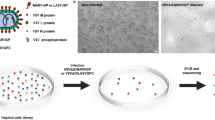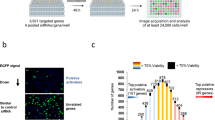Abstract
Human cytomegalovirus encodes at least 25 membrane glycoproteins that are found in the viral envelope1. While gB represents the fusion protein, two glycoprotein complexes control the tropism of the virus: the gHgLgO trimer is involved in the infection of fibroblasts, and the gHgLpUL128L pentamer is required for infection of endothelial, epithelial and myeloid cells2–5. Two reports suggested that gB binds to ErbB1 and PDGFRα (refs 6,7); however, these results do not explain the tropism of the virus and were recently challenged8,9. Here, we provide a 19 Å reconstruction for the gHgLgO trimer and show that it binds with high affinity through the gO subunit to PDGFRα, which is expressed on fibroblasts but not on epithelial cells. We also provide evidence that the trimer is essential for viral entry in both fibroblasts and epithelial cells. Furthermore, we identify the pentamer, which is essential for infection of epithelial cells, as a trigger for the ErbB pathway. These findings help explain the broad tropism of human cytomegalovirus and indicate that PDGFRα and the viral gO subunit could be targeted by novel anti-viral therapies.
This is a preview of subscription content, access via your institution
Access options
Subscribe to this journal
Receive 12 digital issues and online access to articles
$119.00 per year
only $9.92 per issue
Buy this article
- Purchase on SpringerLink
- Instant access to full article PDF
Prices may be subject to local taxes which are calculated during checkout




Similar content being viewed by others
References
Vanarsdall, A. L. & Johnson, D. C. Human cytomegalovirus entry into cells. Curr. Opin. Virol. 2, 37–42 (2012).
Hahn, G. et al. Human cytomegalovirus UL131–128 genes are indispensable for virus growth in endothelial cells and virus transfer to leukocytes. J. Virol. 78, 10023–10033 (2004).
Wang, D. & Shenk, T. Human cytomegalovirus virion protein complex required for epithelial and endothelial cell tropism. Proc. Natl Acad. Sci. USA 102, 18153–18158 (2005).
Wang, D. & Shenk, T. Human cytomegalovirus UL131 open reading frame is required for epithelial cell tropism. J. Virol. 79, 10330–10338 (2005).
Ryckman, B. J. et al. Characterization of the human cytomegalovirus gH/gL/UL128–131 complex that mediates entry into epithelial and endothelial cells. J. Virol. 82, 60–70 (2008).
Wang, X., Huong, S. M., Chiu, M. L., Raab-Traub, N. & Huang, E. S. Epidermal growth factor receptor is a cellular receptor for human cytomegalovirus. Nature 424, 456–461 (2003).
Soroceanu, L., Akhavan, A. & Cobbs, C. S. Platelet-derived growth factor-α receptor activation is required for human cytomegalovirus infection. Nature 455, 391–395 (2008).
Isaacson, M. K., Feire, A. L. & Compton, T. Epidermal growth factor receptor is not required for human cytomegalovirus entry or signaling. J. Virol. 81, 6241–6247 (2007).
Vanarsdall, A. L., Wisner, T. W., Lei, H., Kazlauskas, A. & Johnson, D. C. PDGF receptor-α does not promote HCMV entry into epithelial and endothelial cells but increased quantities stimulate entry by an abnormal pathway. PLoS Pathogens 8, e1002905 (2012).
Mocarski, E. S. Jr Immune escape and exploitation strategies of cytomegaloviruses: impact on and imitation of the major histocompatibility system. Cell. Microbiol. 6, 707–717 (2004).
Kenneson, A. & Cannon, M. J. Review and meta-analysis of the epidemiology of congenital cytomegalovirus (CMV) infection. Rev. Med. Virol. 17, 253–276 (2007).
Gerna, G. et al. Rescue of human cytomegalovirus strain AD169 tropism for both leukocytes and human endothelial cells. J. Gen. Virol. 84, 1431–1436 (2003).
Murphy, E. et al. Coding potential of laboratory and clinical strains of human cytomegalovirus. Proc. Natl Acad. Sci. USA 100, 14976–14981 (2003).
Macagno, A. et al. Isolation of human monoclonal antibodies that potently neutralize human cytomegalovirus infection by targeting different epitopes on the gH/gL/UL128–131A complex. J. Virol. 84, 1005–1013 (2010).
Kabanova, A. et al. Antibody-driven design of a human cytomegalovirus gHgLpUL128L subunit vaccine that selectively elicits potent neutralizing antibodies. Proc. Natl Acad. Sci. USA 111, 17965–17970 (2014).
Li, G., Nguyen, C. C., Ryckman, B. J., Britt, W. J. & Kamil, J. P. A viral regulator of glycoprotein complexes contributes to human cytomegalovirus cell tropism. Proc. Natl Acad. Sci. USA 112, 4471–4476 (2015).
Cha, T. A. et al. Human cytomegalovirus clinical isolates carry at least 19 genes not found in laboratory strains. J. Virol. 70, 78–83 (1996).
Feire, A. L., Koss, H. & Compton, T. Cellular integrins function as entry receptors for human cytomegalovirus via a highly conserved disintegrin-like domain. Proc. Natl Acad. Sci. USA 101, 15470–15475 (2004).
Feire, A. L., Roy, R. M., Manley, K. & Compton, T. The glycoprotein B disintegrin-like domain binds β1 integrin to mediate cytomegalovirus entry. J. Virol. 84, 10026–10037 (2010).
Ciferri, C. et al. Antigenic characterization of the HCMV gH/gL/gO and pentamer cell entry complexes reveals binding sites for potently neutralizing human antibodies. PLoS Pathogens 11, e1005230 (2015).
Loughney, J. W. et al. Soluble human cytomegalovirus gH/gL/pUL128–131 pentameric complex, but not gH/gL, inhibits viral entry to epithelial cells and presents dominant native neutralizing epitopes. J. Biol. Chem. 290, 15985–15995 (2015).
Zhou, M., Lanchy, J. M. & Ryckman, B. J. Human cytomegalovirus gH/gL/gO promotes the fusion step of entry into all cell types, whereas gH/gL/UL128–131 broadens virus tropism through a distinct mechanism. J. Virol. 89, 8999–9009 (2015).
Schultz, E. P., Lanchy, J. M., Ellerbeck, E. E. & Ryckman, B. J. Scanning mutagenesis of human cytomegalovirus gH/gL. J. Virol. 90, 2294–2305 (2015).
Haspot, F. et al. Human cytomegalovirus entry into dendritic cells occurs via a macropinocytosis-like pathway in a pH-independent and cholesterol-dependent manner. PLoS ONE 7, e34795 (2012).
Sinzger, C., Digel, M. & Jahn, G. Cytomegalovirus cell tropism. Curr. Top. Microbiol. Immunol. 325, 63–83 (2008).
Wille, P. T., Wisner, T. W., Ryckman, B. & Johnson, D. C. Human cytomegalovirus (HCMV) glycoprotein gB promotes virus entry in trans acting as the viral fusion protein rather than as a receptor-binding protein. MBio 4, e00332 (2013).
Campadelli-Fiume, G., Menotti, L., Avitabile, E. & Gianni, T. Viral and cellular contributions to Herpes simplex virus entry into the cell. Curr. Opin. Virol. 2, 28–36 (2012).
Compton, T., Nepomuceno, R. R. & Nowlin, D. M. Human cytomegalovirus penetrates host cells by pH-independent fusion at the cell surface. Virology 191, 387–395 (1992).
Ryckman, B. J., Jarvis, M. A., Drummond, D. D., Nelson, J. A. & Johnson, D. C. Human cytomegalovirus entry into epithelial and endothelial cells depends on genes UL128 to UL150 and occurs by endocytosis and low-pH fusion. J. Virol. 80, 710–722 (2006).
Wang, D., Yu, Q. C., Schroer, J., Murphy, E. & Shenk, T. Human cytomegalovirus uses two distinct pathways to enter retinal pigmented epithelial cells. Proc. Natl Acad. Sci. USA 104, 20037–20042 (2007).
Essletzbichler, P. et al. Megabase-scale deletion using CRISPR/Cas9 to generate a fully haploid human cell line. Genome Res. 24, 2059–2065 (2014).
Traggiai, E. et al. An efficient method to make human monoclonal antibodies from memory B cells: potent neutralization of SARS coronavirus. Nature Med. 10, 871–875 (2004).
Mastronarde, D. N. Automated electron microscope tomography using robust prediction of specimen movements. J. Struct. Biol. 152, 36–51 (2005).
Tang, G. et al. EMAN2: an extensible image processing suite for electron microscopy. J. Struct. Biol. 157, 38–46 (2007).
Shaikh, T. R. et al. SPIDER image processing for single-particle reconstruction of biological macromolecules from electron micrographs. Nature Protoc. 3, 1941–1974 (2008).
Yang, Z., Fang, J., Chittuluru, J., Asturias, F. J. & Penczek, P. A. Iterative stable alignment and clustering of 2D transmission electron microscope images. Structure 20, 237–247 (2012).
Hohn, M. et al. SPARX, a new environment for cryo-EM image processing. J. Struct. Biol. 157, 47–55 (2007).
Frank, J. et al. SPIDER and WEB: processing and visualization of images in 3D electron microscopy and related fields. J. Struct. Biol. 116, 190–199 (1996).
Pettersen, E. F. et al. UCSF Chimera—a visualization system for exploratory research and analysis. J. Comput. Chem. 25, 1605–1612 (2004).
Acknowledgements
The authors thank A. von Heyl for graphical representation, the Virologia e Microbiologia, Fondazione IRCCS Policlinico San Matteo, Pavia, Italy, for the HCMV clinical isolate and deficient virus, Horizon Genomics GmbH for the HAP-1 parental line and CRISPR/Cas9 KO cells and Oxford University, Central Proteomics Facility, Oxford, UK, for mass spectrometry analysis. The Institute for Research in Biomedicine is supported by the Helmut Horten Foundation. This project has been funded in part with Federal funds from the Frederick National Laboratory for Cancer Research, National Institutes of Health, under contract no. HHSN261200800001E, and by the Intramural Research Program of the Vaccine Research Center, National Institute of Allergy and Infectious Diseases, National Institutes of Health. Leidos Biomedical Research provided support in the form of a salary for author Y.T.
Author information
Authors and Affiliations
Contributions
A.K., J.M., S.B., D.L. and R.G. performed and analysed the experiments. C.S.-F. and B.M.F.-R. generated new reagents. B.M.F.-R., M.F. and M.P. performed and provided analysis on the gene expression of ARPE-19 and MRC-9 cells. T.Z., U.B., Y.T., A.D., B.Z. and P.D.K. designed, performed and analysed electron microscopy data and expressed and purified the PDGFRα-trimer complex. F.S. provided intellectual input and wrote the manuscript. D.C. designed experiments, analysed the data and wrote the manuscript. A.L. designed experiments, analysed the data, wrote the manuscript and provided supervision. L.P. designed experiments, analysed the data, provided supervision and wrote the manuscript.
Corresponding authors
Ethics declarations
Competing interests
The authors declare no competing financial interests.
Supplementary information
Supplementary information
Supplementary Figures 1-11 and Supplementary Tables 1-3 (PDF 40574 kb)
Rights and permissions
About this article
Cite this article
Kabanova, A., Marcandalli, J., Zhou, T. et al. Platelet-derived growth factor-α receptor is the cellular receptor for human cytomegalovirus gHgLgO trimer. Nat Microbiol 1, 16082 (2016). https://doi.org/10.1038/nmicrobiol.2016.82
Received:
Accepted:
Published:
DOI: https://doi.org/10.1038/nmicrobiol.2016.82
This article is cited by
-
Cytomegalovirus cell tropism and clinicopathological characteristics in gastrointestinal tract of patients with HIV/AIDS
Diagnostic Pathology (2022)
-
Modulation of host cell signaling during cytomegalovirus latency and reactivation
Virology Journal (2021)
-
The structural basis of herpesvirus entry
Nature Reviews Microbiology (2021)
-
A conditionally replication-defective cytomegalovirus vaccine elicits potent and diverse functional monoclonal antibodies in a phase I clinical trial
npj Vaccines (2021)
-
Transmission of cell-associated human cytomegalovirus isolates between various cell types using polymorphonuclear leukocytes as a vehicle
Medical Microbiology and Immunology (2021)



